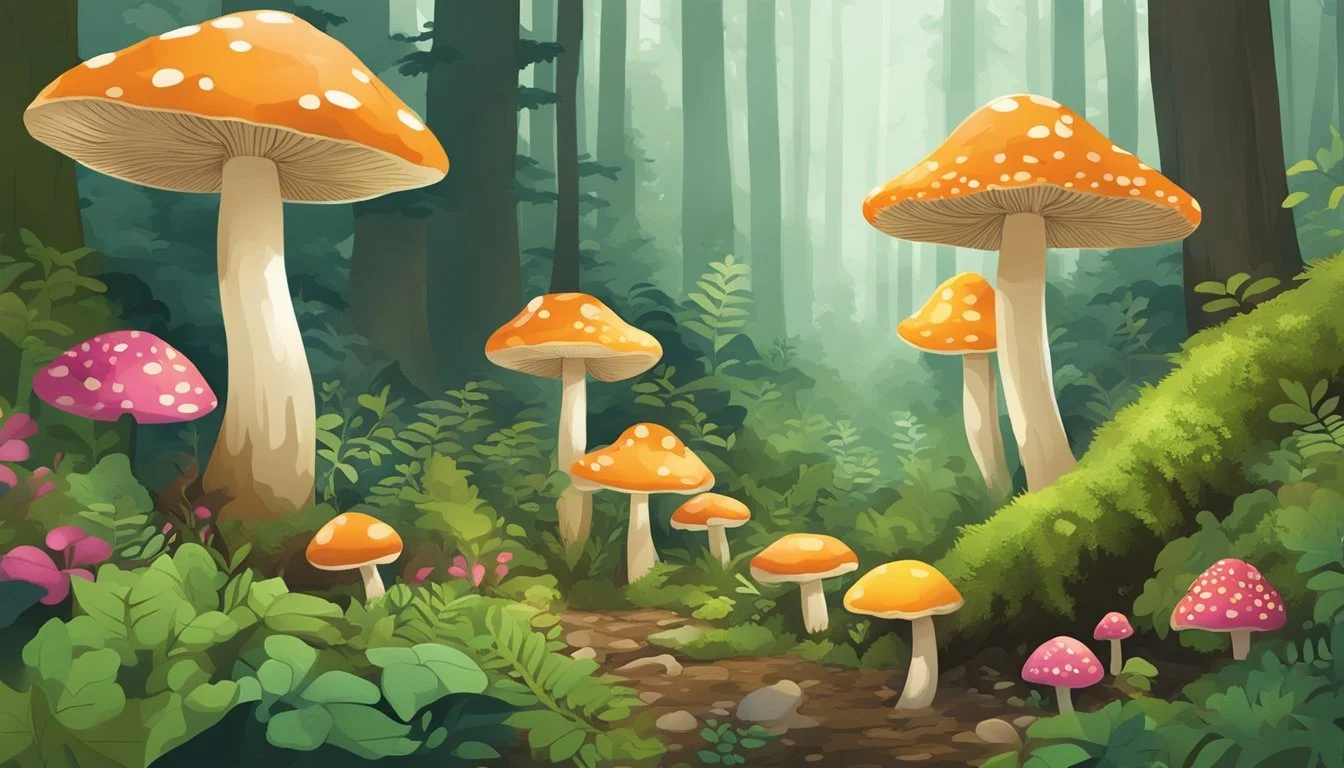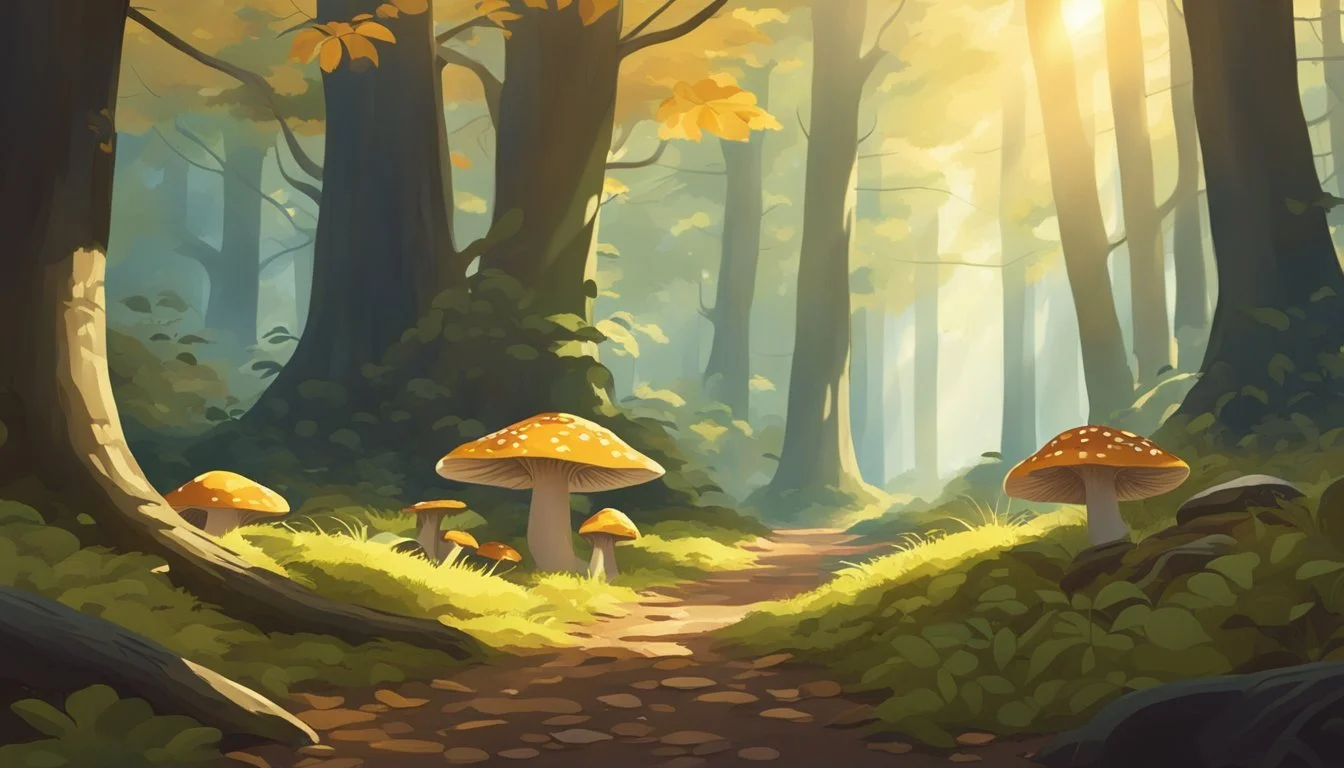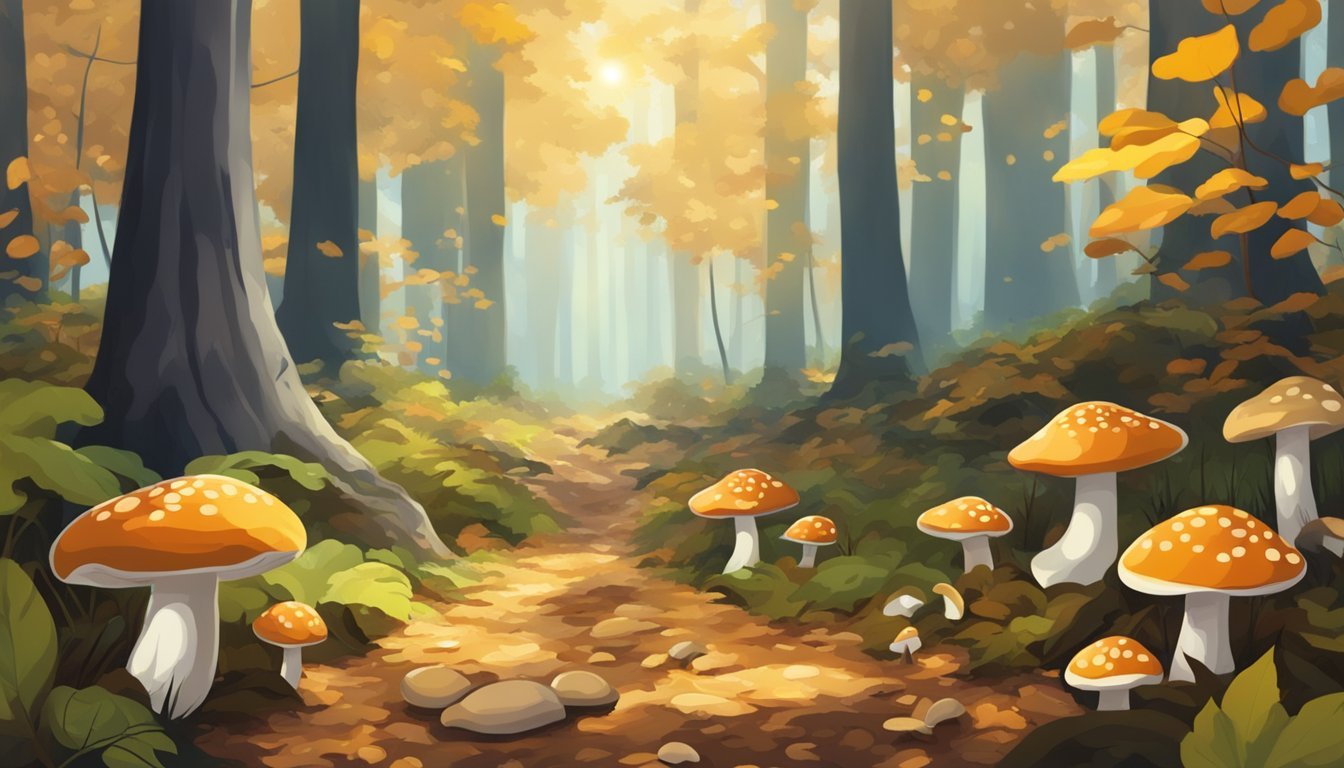Mushroom Hunting New York
Expert Guide to Foraging Wild Species
This Article is Part of Our Guide on Mushroom Hunting for All 50 States
Mushroom hunting in New York offers a diverse array of fungi due to the state's varied ecosystems, presenting an exciting activity for nature enthusiasts and culinary adventurers alike. With forests, parks, and rural areas, New York is a fertile ground for mushrooms (What wine goes well with mushrooms?) such as the Giant Puffball, Bear's Head Tooth, Golden Chanterelle, and the sought-after King Bolete. The practice requires a keen eye and knowledge of the local species to ensure both safety and success.
Enthusiasts often connect through community groups, like the New York Mycological Society, to share expertise and organize foraging expeditions. These groups emphasize education and safety, helping both novices and experienced foragers to correctly identify edible species while being mindful of the inedible or poisonous varieties. They often hold meetings and foraging events, paving the way for a blend of social interaction and the fostering of a deeper understanding of New York's mycological wealth.
Given the importance of proper identification and sustainable practices, many foragers take advantage of local guides and foraging classes. Such resources are invaluable, especially considering the subtle distinction between certain edible mushrooms and their toxic lookalikes. For those interested in the culinary aspects, foraging in New York can lead to discoveries that enrich their cooking with wild and natural flavors local to the state.
Foraging for More Than Just Mushrooms in New York
New York's vast wilderness, from the Adirondacks to the Catskills, is a forager's paradise offering a diverse array of wild edibles beyond the well-known mushrooms. The Empire State's rich ecosystems provide a bounty of nuts, berries, greens, and roots. Discover the joys of foraging and reconnect with nature's abundance in New York's picturesque landscapes.
👉 Foraging for Wild Edibles in New York
Commonly Found Edible Mushrooms in New York
New York is home to several edible mushroom species. Some of the most commonly found edible mushrooms in the state include:
Morel (Morchella spp): Commonly found in New York, morel mushrooms have a distinctive honeycomb appearance and are prized for their rich, earthy flavor.
Maitake (Grifola frondosa): Also known as hen of the woods, these mushrooms are frequently found at the base of oak trees in New York and are known for their meaty texture and rich, earthy flavor.
Chanterelle (Cantharellus spp): These golden to yellowish-orange mushrooms are often found in wooded areas in New York and have a delicate, fruity aroma and a mild, peppery taste, making them a sought-after culinary ingredient.
Porcini (Boletus edulis): Commonly found in New York, porcini mushrooms have a nutty flavor and a meaty texture, making them a popular choice for cooking and foraging.
Chicken of the Woods (Laetiporus sulphureus): Often found on decaying hardwood trees in New York, these bright orange shelf-like mushrooms have a soft texture and a flavor reminiscent of chicken, making them a unique and flavorful addition to dishes.
Hen of the Woods (Grifola frondosa): Not to be confused with Hen of the Forest. Has a roasted, earthy flavor and can often be found at the base of oaks.
Ringless Honey Mushroom (Armillaria tabescens): Grows in clusters around wood, though not a honey fungus. Should be researched thoroughly as it may be confused with other species.
It is essential to properly identify any mushroom before consuming it, as some species can be poisonous. Beginners should go mushroom hunting with an experienced guide or join a local mycological society to learn how to identify edible mushrooms safely.
Getting Started with Mushroom Hunting
Embarking on a mushroom forage in New York requires familiarity with the region's fungi, attention to safety, and appropriate preparation. This section equips mushroom hunters with the essential knowledge and tools needed for a successful forage.
Understanding the Basics
In New York, mushrooms grow prolifically, with species like King Bolete (Boletus edulis) and Oyster mushrooms (Pleurotus ostreatus) being quite popular. Foragers should start their hunting efforts in early spring or fall when these fungi are most likely to emerge. A reliable guide is indispensable for identifying both edible species and varieties like the white death angel, which is highly toxic.
Mushroom Hunting Safety
Safety in mushroom hunting cannot be overstressed. Mushroom hunters should always:
Never consume a mushroom unless it's positively identified as safe for consumption.
Be aware of poisonous mushrooms, such as the white death angel (Amanita bisporigera), which resembles edible varieties.
Hunt in pairs or groups, especially when venturing into unfamiliar or dense areas.
Equipment and Preparation
Proper equipment greatly enhances the foraging experience. Mushroom hunters should prepare with:
A basket or mesh bag for collected mushrooms, allowing spores to disperse and promote further growth.
Comfortable, weather-appropriate clothing and sturdy walking shoes.
A knife for clean cuts and a brush for dirt removal.
Access to a mushroom identification guide or digital resource to confirm species during the hunt.
Where to Hunt
Mushroom hunting in New York offers a variety of locations ranging from urban parks to dense woodlands where enthusiasts can seek out numerous fungi species. Careful identification and environment respect are crucial elements for a successful forage.
Best Locations in New York
Central Park, New York City: An urban oasis with a surprising diversity of mushrooms, accessible for city dwellers.
Long Island: Offers a mix of woodland areas and parklands conducive to mushroom growth, particularly in the damp seasons of spring and fall.
Note: Always check local regulations regarding foraging in public parks and private property.
Mushroom Habitats and Trees
Mushrooms grow in specific habitats, often associated with certain types of trees. For successful hunting, one should become familiar with these environments:
Oak Trees: Ringless Honey Mushrooms can be found around stumps and trunks.
Damp Woods: Ideal for varieties like Morels and King Boletes; look for natural moisture sources.
Fallen Leaves & Decomposing Logs: A potential goldmine for various species, including the prized Golden Chanterelle.
Remember, each species requires different conditions; thus, understanding the preferred habitat is key.
Identifying Mushrooms
Mushroom hunting in New York requires precise knowledge to distinguish between safe edibles and potentially harmful fungi. Accurate identification is crucial as mushroom varieties can significantly vary in appearance and edibility.
Edible Versus Poisonous
When foraging for mushrooms, the primary concern is discerning edible varieties from poisonous ones. It is vital to remember that certain toxic mushrooms look remarkably similar to edible species. For instance, the White Death Angel (Amanita bisporigera), a highly poisonous fungus, can be mistakenly identified as an edible mushroom due to its white cap and pleasant appearance. On the contrary, the Hen of the Woods (Grifola frondosa) and Chicken of the Woods (Laetiporus sulphureus) are not only edible but also sought after for their taste and versatility in cooking.
Critical factors for identification:
Cap shape and color
Presence and color of gills
Stem color and texture
Spore print color
Always cross-reference with reliable sources before consumption.
Foraging Times and Seasons
Mushroom foraging in New York offers a dynamic experience as species thrive at different times of the year, largely influenced by the weather and soil conditions.
When to Forage Mushrooms
Mushroom enthusiasts can find varieties throughout the year, but peak foraging season occurs from early spring through late fall. Spring mushrooms start appearing as early as March, with more varieties burgeoning as the season progresses. Morels are often the first to be sought after in spring. By the time it's May, the conditions are right for a wider array of species.
Early Spring (March to April): Morels
Late Spring (May to June):
Oyster mushrooms (Pleurotus ostreatus)
Chicken of the Woods (Laetiporus sulphureus)
Summer (July to August):
Chanterelles (Cantharellus cibarius)
Giant Puffball (Calvatia gigantea)
Fall (September to November):
Hen of the Woods (Grifola frondosa)
Bear's-Head Tooth (Hericium americanum)
Weather Patterns and Mushroom Growth
Mushroom growth is significantly influenced by weather patterns, particularly rainfall. Mushrooms thrive in moist conditions and periods after rain are often the most bountiful for foragers. However, enthusiasts should note that prolonged dry spells can delay or decrease the production of some species. It's essential to track local weather conditions closely when planning foraging excursions.
Local Mycology Resources
New York offers a variety of mycological resources for enthusiasts interested in learning about and hunting for mushrooms. From established societies to park programs, these resources provide a wealth of knowledge on local fungi.
New York Mycological Society
The New York Mycological Society is a cornerstone organization for mushroom aficionados in the city. Founded in the 1950s, it serves as a hub for those interested in mycology. The society offers educational resources, organizes forays, and is committed to promoting the study and enjoyment of fungi. Members have access to a network of experienced mycologists and opportunities for hands-on learning.
Location: c/o Sigrid Jakob, 259 21st. St., Brooklyn, NY 11225
Activities: Mushroom hunting trips, identification workshops, guest lectures
Parks and Recreation Guidance
New York's park rangers are knowledgeable about the variety of edible plants and mushrooms within park boundaries. They can provide guidance on where to find certain species and how to forage responsibly. Park policies aim to preserve the delicate ecosystem, ensuring that mushroom hunting is both a safe and sustainable adventure.
Guidelines:
Seek ranger advice for locations and safety tips.
Follow park regulations to protect wildlife and habitats.
Mycological Events and Walks
Throughout New York, mycological events and nature walks offer an educational experience regarding local mushrooms. Participants can learn to identify common edible and toxic species while exploring the natural environment. These events are often suitable for a range of experience levels, from beginners to seasoned foragers.
Opportunities: Guided walks, themed events, community science projects
Experience: Suitable for all levels; fosters community and education.
Sustainable Mushroom Hunting Practices
When foragers seek mushrooms in the forests and green spaces of New York, sustainability should be at the forefront of their practices. Adherence to sustainable foraging protocols ensures that mushroom populations continue to thrive for future generations.
A fundamental aspect of responsible foraging involves correct identification. Foragers must be thoroughly knowledgeable about mushroom species to avoid harming inedible or endangered varieties. As a rule, they should collect only mushrooms they can positively identify, leaving behind any specimens in doubt.
Foragers should adhere to the following practices when collecting mushrooms:
Take Only What You Need: Overharvesting can lead to a decline in mushroom populations. Limit harvest to ensure fungi can continue to grow and reproduce in their natural habitat.
Harvest Mature Specimens: Picking young, developing mushrooms can prevent them from releasing spores, which are crucial for propagation.
Cut, Don't Pull: Use a knife to gently cut the mushroom stem above the soil to minimize disturbance to the mycelium below.
In addition to foraging practices, individuals can cultivate edible mushrooms in their own gardens to reduce the pressure on wild populations. Home cultivation kits for species such as oyster mushrooms are available, allowing for a more sustainable and continual harvest.
In conclusion, sustainability in mushroom hunting is achieved through education, respectful harvesting, and personal cultivation, ensuring that mushroom foraging remains a viable activity for enthusiasts and contributes positively to the ecosystem.
Incorporating Mushrooms into Cuisine
Mushroom hunting in New York can lead to an exciting array of edible mushrooms, each bringing a distinct taste to the table. Chefs and home cooks alike savor the robust flavors of varieties such as the King Bolete (Boletus edulis), also known as porcini, and the delicate, slightly sweet notes of Oyster mushrooms (Pleurotus ostreatus).
Hen of the woods, or Grifola frondosa, is another treasured find amongst fungi foragers. Its rich, earthy flavor, coupled with a meaty texture, makes it versatile in the kitchen. One can sauté it with garlic and herbs for a simple side dish, or incorporate it into risottos for added depth.
The elusive morel (Morchella species), a prized mushroom, is celebrated for its nutty and umami-packed taste. Morels elevate dishes when paired with creamy sauces, or they can be lightly fried for a crisp, savory treat.
For culinary enthusiasts looking to incorporate wild mushrooms into their cuisine, consider the following preparation tips:
Cleaning: Brush off dirt gently; avoid soaking, as mushrooms absorb water.
Cooking: Sauté or roast to highlight their natural flavors.
Pairings: Complement with ingredients that enhance their taste without overpowering them.
Below is a list of common preparation methods:
Sautéed: With butter, garlic, and parsley.
Roasted: Drizzled with olive oil and seasoned with salt.
Stuffed: Filled with cheese, breadcrumbs, and herbs, then baked.
Pickled: In a brine with vinegar and spices, for preservation.
In conclusion, incorporating wild mushrooms into dishes can transform the mundane into the extraordinary. When cooking with them, always prioritize the mushrooms' natural flavor to truly showcase what New York's forests have to offer.
Conclusion
Mushroom hunting in New York, while seemingly an anomaly, has proven to be both a viable and engaging pursuit. The New York Mycological Society and other enthusiasts regularly explore locales like Central Park and beyond, uncovering a surprisingly diverse range of fungi. Safety and education are paramount, as the region is home to both edible and toxic species.
One must heed the importance of:
Identifying mushrooms accurately
Respecting local laws and private properties
Preserving habitats for future foragers
With these principles, urban foragers can enjoy the rewards of mushroom hunting responsibly. Interaction with nature in an urban environment like New York City offers a unique juxtaposition that challenges the stereotype of foraging as a purely rural activity.
For those interested in engaging with the local mycological community, one may consider:
Joining local mycological societies
Participating in foraging walks and talks
Sharing knowledge and experience
As natural spaces within urban settings receive greater appreciation, the pastime of mushroom hunting stands as a testament to the resilience of nature and the curiosity of the urban dwellers who seek to connect with it.






